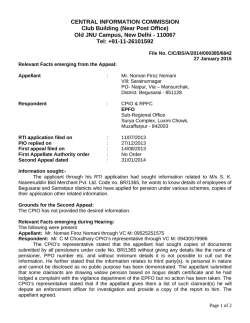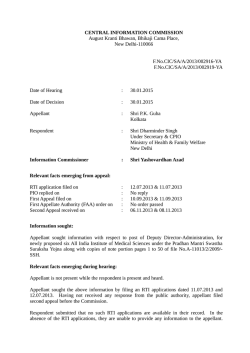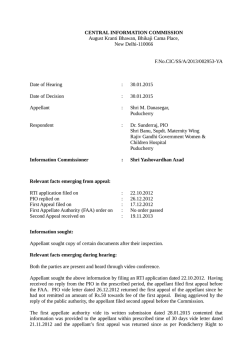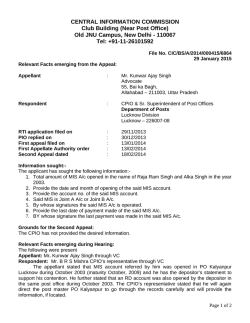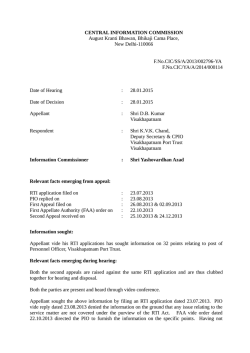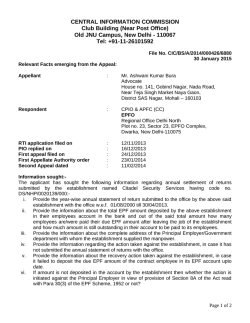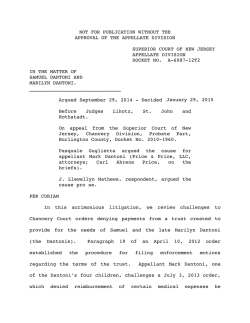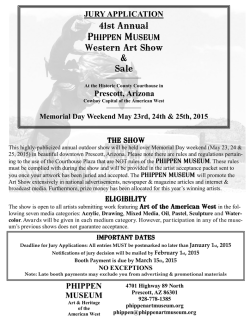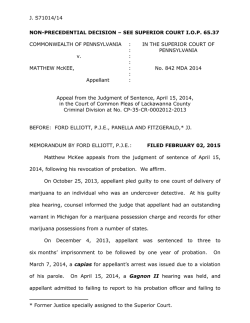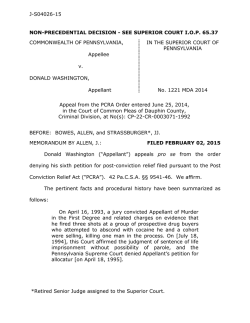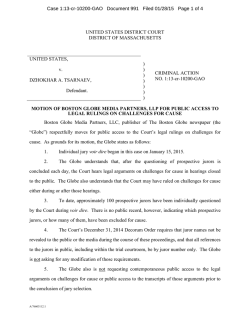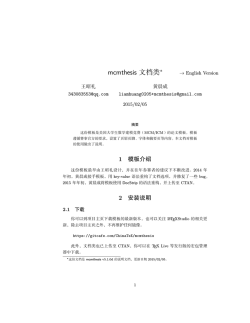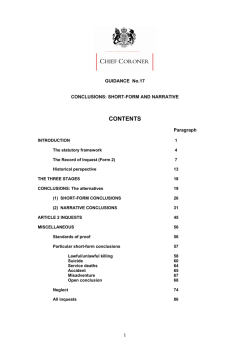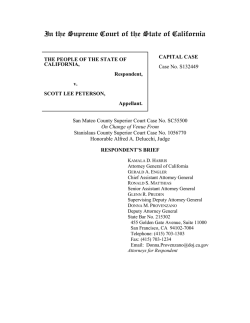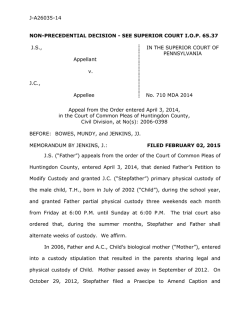
COURT OF APPEALS EIGHTH DISTRICT OF TEXAS EL PASO
COURT OF APPEALS EIGHTH DISTRICT OF TEXAS EL PASO, TEXAS ROBERT ANTHONY CANTU, Appellant, § § v. § THE STATE OF TEXAS, § Appellee. § § No. 08-12-00348-CR Appeal from the 243rd District Court of El Paso County, Texas (TC# 20090D05872) OPINION Appellant Robert Anthony Cantu appeals his conviction for sexual assault of a child. The jury found Appellant guilty of sexually assaulting A.M. by penetrating her sexual organ with his finger, but not guilty of sexually assaulting A.M. by causing her sexual organ to contact his mouth. See TEX. PENAL CODE ANN. § 22.011(a)(2)(A, C). The trial court assessed punishment at two years’ confinement. As in many sexual assault cases, the child, A.M., was the only witness to the crime to testify. Appellant attacked A.M’s credibility at trial, arguing she was delusional or simply fabricating the assault for some unknown reason. The trial court allowed the State to buttress its case by allowing two police detectives to testify A.M. was credible. The State concedes this was error, but argues the error was harmless. After conducting a full harm analysis of the entire record, we agree the error was harmless and affirm the conviction. FACTUAL BACKGROUND A.M.’s father and Appellant Robert Cantu were close friends. On the evening of March 8, 2009, A.M. spent the night at the Cantu residence.1 A.M. fell asleep on the couch while watching television in the living room. A.M. testified that sometime after 3 a.m., she awoke to find Appellant with his mouth on her vagina. When A.M. asked what he was doing, Appellant stopped and left the room without responding. A.M. testified that although she felt weird, dirty, confused, and scared, she turned over and fell back asleep. Later, A.M. awoke to find Appellant with his hand down the front of her pants and his fingers inside her labia. When A.M. told Appellant to stop, he replied that “he had already been down there,” that he loved her, and that she should give him a goodnight kiss.2 A.M. told Appellant to “just go to bed,” and Appellant left and went into the kitchen. A.M. went to the bathroom and washed herself because she felt “gross.” A.M. started to make an emergency 911 call, but when her cell phone beeped loudly, she did not complete the call, fearing Appellant would hear her calling for help. A.M., wearing only her sleeping clothes and socks, then left the house by going through the dog door backwards, so she could watch Appellant, who was asleep, and because it was quieter than using the other doors. A.M. climbed over the backyard rock wall, injuring herself in the process, and walked through the desert to the street and called 911.3 1 A.M. was 14 years’ old at the time. A.M.’s sister testified about a prior incident when she spent the night at the Cantu residence in 2007 and awoke to find Appellant lying on top of her with his head on her lap. When she retreated to a bedroom, Appellant followed, telling her “I love you[.]” 3 A redacted version of the 911 audio recording was played for the jury who heard A.M. telling the operator that she woke up to find Appellant’s hand in her privates. 2 2 Detective Alejandro Alvarez was dispatched to the scene. He found A.M. on the sidewalk at the corner. He observed that A.M. was not wearing any shoes and was also without a jacket on a cold morning. A.M. asked the officers to move their vehicle away from the residence because she did not want Appellant to see her talking with them. A.M. related what had happened to Detective Alvarez. Over objection, Detective Alvarez testified that he found A.M. credible. After interviewing A.M., Alvarez went to the Cantu residence and spoke to Appellant, informing him of the allegations, which Appellant denied. He observed that Appellant did not appear surprised that A.M. was not in the house. After conducting his investigation, Alvarez took A.M. to the hospital for a rape exam. The examination and the subsequent lab testing did not disclose any physical evidence such as injuries to A.M.’s vagina or the presence of foreign DNA.4 Detective Nevarez with the Crimes Against Children Unit interviewed A.M. about one month after the sexual assault. During the interview, A.M. told Detective Nevarez what had happened. Over objection, Detective Nevarez testified that she thought A.M. was telling the truth and that she found A.M. to be credible. THE STATE CONCEDES ERROR In four related issues, Appellant complains the trial court abused its discretion in admitting the following testimony of Detective Alvarez and Detective Nevarez that A.M was truthful and credible: [Detective Alvarez] 4 The sexual-assault nurse examiner observed small abrasions on A.M.’s wrist and calf and a bruise on A.M.’s leg, but did not observe any injuries to A.M.’s vagina. A.M.’s genital area was swabbed for dried saliva to collect DNA, but the nurse testified that she would not expect to find DNA evidence because A.M. had washed herself. Subsequent testing did not disclose any semen and found only A.M.’s DNA in the samples. The analyst testified that she would not expect to find another person’s DNA in a sample where the victim had washed herself, urinated, and cleaned up the area where the DNA was collected. 3 Q: After interviewing [A.M.], the victim, noticing her demeanor, how she was acting, talking to the defendant, his family and her and her family, did you believe the victim? …[objection and intervening argument] Q: Detective Alvarez, after interviewing the complaining witness, did you find her credible? A: Yes, I did. [Detective Nevarez] Q: Okay. You had an opportunity to sit down with [A.M.], observe her demeanor, did you think she was telling the truth? A: Yes. …[objection] The Witness: Yes, I did. I found her to be credible. Appellant argues this testimony was erroneously admitted because a witness may not give a direct opinion as to the truthfulness of another witness. We agree, and the State concedes that admission of this testimony was error. As we have previously noted, both lay and expert opinions as to the truthfulness of another witness invade the province of the jury and are inadmissible. Arzaga v. State, 86 S.W.3d 767, 776 (Tex.App. – El Paso 2002, no pet.) (a direct opinion as to the truthfulness of another witness “is inadmissible because it does more than assist the trier of fact to understand the evidence or to determine a fact in issue; it impermissibly decides an issue for the jury”); see Brookins v. State, No. 08-10-00242-CR, 2011 WL 6357786, at *2 (Tex.App. – El Paso Dec. 14, 2011, pet. ref’d) (“A witness may not give a direct opinion as to the truthfulness of another witness.”); see also Barshaw v. State, 342 S.W.3d 91, 93 (Tex.Crim.App. 2011) (expert testimony that a particular class of persons to which the victim belongs is truthful is inadmissible); 4 Yount v. State, 872 S.W.2d 706, 712 (Tex.Crim.App. 1993) (“We hold that Rule 702 does not permit an expert to give an opinion that the complainant or class of persons to which the complainant belongs is truthful.”). HARM ANALYSIS Thus, we proceed to determine if the admission of this testimony was harmful to Appellant. The erroneous admission of testimony regarding the truthfulness of a witness is non-constitutional error, which must be disregarded unless it affected the defendant’s substantial rights. See Barshaw, 342 S.W.3d at 93; see also TEX.R.APP.P. 44.2(b). We must reverse a conviction for non-constitutional error if we have “grave doubt” that the result of the trial was free from the substantial effect of the error. Barshaw, 342 S.W.3d at 94. On the other hand, we will not reverse if, after examining the record as a whole, we have fair assurance that the error did not influence the jury or influenced the jury only slightly. Id. at 93. Our focus is not on whether the outcome of the trial was proper despite the error, but whether the error had a substantial or injurious effect on the jury’s verdict. Id. at 93-94. In assessing the likelihood that the jury’s decision was improperly influenced, we must make “a full harm analysis based on the entirety of the record[.]” Id. at 96. In doing so, we examine everything in the record, including any testimony or physical evidence admitted for the jury’s consideration, the nature of the evidence supporting the verdict, the character of the error and how it relates to the other evidence in the case, the theory of the prosecution and defense, the jury instructions, the closing arguments, and whether the state emphasized the error. Id. at 94. Appellant argues “this was an extremely close case,” as shown by its procedural history. He points out that the first attempt to try this case ended in mistrial after the jury could not reach a 5 verdict, despite being given an Allen charge.5 Then, in the second trial the jury reached a verdict only after first indicating they were deadlocked. Appellant also notes the jury reached what he describes as a “solomonesque verdict,” finding him guilty on the penetration count but not guilty on the contact count. Appellant also points out the verdict was unsupported by any physical evidence and thus turned on the credibility of the complaining witness. He contends this “case stood on a razor’s edge, and even with double bolstering of the complaining witness, barely fell on the State’s side.” He asserts the State compounded the error when it argued in closing: You also got to hear from Detective Alvarez, Crimes Against Children detective. He said yes, I talked to her at the time I got a chance to look at her she seemed credible. Detective Nevarez, I got [a] chance to look at her at the time, I believed her.6 Appellant is correct that A.M.’s credibility was a key issue due to the absence of corroborating evidence such as physical evidence or eyewitness testimony. See Rhodes v. State, 308 S.W.3d 6, 11 (Tex.App. – Eastland 2009, pet. dism’d) (recognizing credibility was a key issue “because of the absence of corroborating evidence such as physical evidence or eye-witness testimony”). That the case against Appellant rested on the credibility of the complainant, however, “is significant, but it is not conclusive.” Schutz v. State, 63 S.W.3d 442, 446 (Tex.Crim.App. 2001). The inadmissible testimony here was only a small portion of a large amount of evidence presented to the jury from which it could have considered in assessing A.M.’s credibility. “Even in cases in which credibility is paramount, Texas courts have found harmless error when the inadmissible expert testimony was only a small portion of a large amount of evidence presented 5 Allen v. U.S., 164 U.S. 492 (1896). We also note the State argued earlier: “you’ve heard two detectives that [sic] testified about [A.M.’s] credibility.” And, later the State indirectly argued that it had produced witnesses “who never met [A.M.] before in their life, and they said I believe that little girl, and I think you believe her too.” 6 6 that the jury could have considered in assessing the victim’s credibility.” Barshaw, 342 S.W.3d at 96; see Schutz, 63 S.W.3d at 446 (“Suffice it to say, the inadmissible expert testimony was a small portion of a large amount of evidence presented that the jury could have considered in assessing the victim’s credibility.”). This was not a case in which a young child testifies briefly about the crime and is subject to little or no cross-examination. A.M. was 17 at the time of trial and testified at length on exactly what happened that night, giving the jury a significant opportunity to see, hear, and judge her credibility from her testimony alone. The jury was also able to test A.M.’s credibility by comparing her testimony with the accounts of the events she gave to Detective Alvarez, Detective Nevarez, the sexual assault nurse, and the 911 operator. Moreover, defense counsel subjected A.M. to a lengthy and rigorous cross-examination that probed deeply into the various inconsistencies in A.M.’s story. By comparison, the statements of Detective Alvarez and Detective Nevarez were short and to the point, and made without elaboration.7 See Rhodes, 308 S.W.3d at 11 (where the court found the error harmless in part because the witness answered only two questions affirmatively and without elaboration). Because the jury had ample opportunity to judge A.M.’s credibility from evidence independent of the detectives’ opinions as to her truthfulness, we conclude the evidence did not have a substantial or injurious effect or influence in determining the jury’s verdict. See Arzaga, 86 S.W.3d at 777 (concluding there was no harm because the jury had ample opportunity to judge the credibility of the witness independent of the erroneously-admitted opinion on truthfulness). 7 We note that generally those cases in which the courts have found harm have involved rather extensive scientific and statistical testimony from expert witnesses regarding the truthfulness of sexual abuse victims. See, e.g., Wiseman v. State, 394 S.W.3d 582, 584-86 (Tex.App. – Dallas 2012, pet. ref’d) (where expert witness gave a “statistical opinion on the truthfulness of sexual abuse complainants”). 7 Likewise, the prosecutor’s reference in closing argument to Detectives Alvarez’ and Nevarez’ testimony that they found A.M. truthful and credible, was but a small portion of the prosecutor’s closing, which emphasized all the other reasons the jury should believe A.M. See Rhodes, 308 S.W.3d at 11 (where the court found the error harmless in part because the State’s closing argument primarily addressed other reasons the complainant was credible and made only minimal reference to the improper testimony). The prosecutor emphasized instead the consistency of A.M.’s story, the 911 call, the sexual assault nurse testimony, the medical records, and the testimony of A.M.’s sister about experiencing a similar incident with Appellant. Although the prosecutor’s reference may have arguably had some tendency to reinforce the improper testimony, the jury was properly instructed that it was the exclusive judge of witness credibility. See Barshaw, 342 S.W.3d at 96 (noting the jury was instructed that it was the sole judge of the witnesses’ credibility); Brookins, 2011 WL 6357786, at *3. But, most important, Appellant’s reliance on the jury finding him guilty on the penetration case but not guilty on the contact case is misplaced. In fact, the jury’s acquittal in one case and conviction in the other shows the jury did not unconditionally believe the complainant and did not allow the testimony as to her credibility to supplant its own decision. The Court of Criminal Appeals addressed this issue in Schutz v. State. There, the appellant was tried for aggravated sexual assault of his six-year-old daughter, and the trial court erred in allowing expert testimony concerning the truthfulness of the complainant. 63 S.W.3d at 443. The jury acquitted the appellant of aggravated sexual assault by penetration and convicted him of aggravated sexual assault by contact. Id. In analyzing the harm analysis performed by the court below, the Court of Criminal Appeals noted the jury had acquitted the appellant in one case and convicted him in 8 another, “so it is apparent that the jury believed some of the complainant’s testimony but not all of it[.]” Id. at 445. The Court recognized that even though this inconsistency could be explained away by reasoning there was more evidence to support a conviction on the contact charge than on the penetration charge, “the acquittal nevertheless shows that the jury did not unconditionally believe the complainant” and “is inconsistent with an acceptance of the child’s credibility.” Id. Consequently, “[g]iven the significance of the acquittal, the record does not support a finding that the jury allowed the expert testimony [as to the complainant’s truthfulness] to supplant its own decision.” Id. Likewise in the present case, the jury’s acquittal on the contact count demonstrated that the erroneously-admitted testimony did not supplant its own decision regarding A.M.’s credibility. CONCLUSION After conducting a full harm analysis of the entire record, we conclude the erroneously-admitted testimony did not affect Appellant’s substantial rights and the error was harmless. We overrule all of Appellant’s issues and affirm the conviction. The trial court certified Appellant’s right to appeal in this case, but the certification does not bear Appellant’s signature indicating that he was informed of his rights to appeal and file a pro se petition for discretionary review with the Texas Court of Criminal Appeals. See TEX.R.APP.P. 25.2(d). The certification is defective. To remedy this defect, this Court ORDERS Appellant’s attorney, pursuant to TEX.R.APP.P. 48.4, to send Appellant a copy of this opinion and this Court’s judgment, to notify Appellant of his right to file a pro se petition for discretionary review, and to inform Appellant of the applicable deadlines. See TEX.R.APP.P. 48.4, 68. Appellant’s attorney is further ORDERED to comply with all of the requirements of TEX.R.APP.P. 48.4. 9 STEVEN L. HUGHES, Justice January 30, 2015 Before McClure, C.J., Rodriguez, and Hughes, JJ. (Do Not Publish) 10
© Copyright 2026
